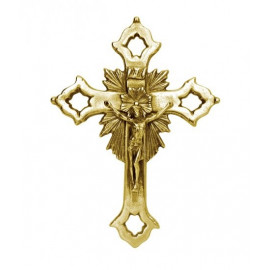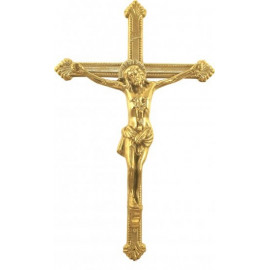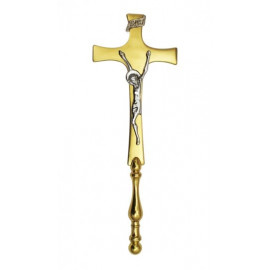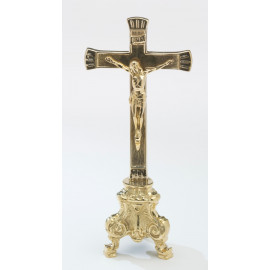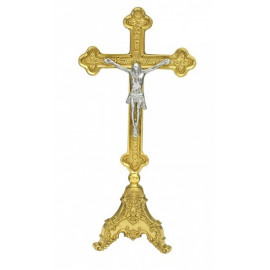No products
Product successfully added to your shopping cart
There are 0 items in your cart. There is 1 item in your cart.
Crosses and Crucifix
- Altar Bell and Gong
- Candle Snuffer
- Candlestick
- Catholic Pyx
- Chalices
- Church wall lamps
- Ciborium
- Crosses and Crucifix
- Cruets & Trays
- Holy Water Font
- Holy Water Pot
- Missal Stand
- Monstrance Tabor
- Monstrances
- Offering Baskets
- Oil Stock
- Patens
- Reliquaries
- Sanctuary Bells
- Sanctuary Lamp
- Sprinkler
- Thurible, Boat, & Spoon
- Travel Liturgy & Mass Kit
Church crosses are a prominent feature of Christianity and are used widely in churches, on top of church buildings, on bibles, in heraldry, in personal jewelry, on hilltops, and elsewhere as an attestation or other symbol of Christianity. Crosses are a prominent feature of Christian cemeteries, either carved on gravestones or as sculpted stelae. In many Christian traditions, communicants are expected to wear a cross necklace at all times, and many Christians continue the practice of hanging a Christian cross in their homes, often on the east wall. Crosses or crucifixes are often the center of a Christian family's home altar as well. In many Christian churches, the altar cross sits atop or is suspended above the altar table and is a focal point of the chancel. Large crucifixes are a prominent feature of some Lutheran churches, e.g. as a rood.
Church crosses are a prominent feature of Christianity and are used widely in churches, on top of church buildings, on bibles, in heraldry, in personal jewelry, on hilltops, and elsewhere as an attestation or other symbol of Christianity. Crosses are a prominent feature of Christian cemeteries, either carved on gravestones or as sculpted stelae. In many Christian traditions, communicants are expected to wear a cross necklace at all times, and many Christians continue the practice of hanging a Christian cross in their homes, often on the east wall. Crosses or crucifixes are often the center of a Christian family's home altar as well. In many Christian churches, the altar cross sits atop or is suspended above the altar table and is a focal point of the chancel. Large crucifixes are a prominent feature of some Lutheran churches, e.g. as a rood.
Crosses and Crucifix There are 5 products.
The Significance of Church Crosses
Church crosses stand as powerful symbols within the Christian faith, embodying both the suffering and the triumphant resurrection of Jesus Christ. These crosses are not just religious emblems; they serve as a constant reminder of the Christian narrative and the foundational beliefs that sustain the faith. From the towering crosses atop church steeples to the intimate crosses adorning altars and sanctuaries, each one carries a story and a significance that resonates deeply with believers.
Varieties of Church Crosses and Their Meanings
The Latin Cross
The Latin Cross, with its longer vertical arm and shorter horizontal bar, is perhaps the most recognized form of church crosses. It is emblematic of the crucifixion of Jesus, a poignant reminder of His sacrifice for humanity's sins. This cross is a staple in many Christian denominations and often serves as the focal point in church architecture and design.
The Greek Cross
Equally, proportioned arms characterize the Greek Cross, symbolizing the wholeness and unity of creation. It is a reminder that the message of Christ and the reach of the church extends in all directions, touching all aspects of life.
The Celtic Cross
The Celtic Cross, distinguished by its unique circle intersecting the cross arms, represents eternity and the unending love of God. Its intricate knotwork and designs often tell stories of faith, heritage, and the intertwining of the divine with the earthly.
The Crucifix
A crucifix is a cross that includes a representation of Jesus' body, known as a corpus. It serves as a vivid representation of Christ's suffering, and is particularly prominent in Catholic and Orthodox traditions.
The Role of Crosses in Church Worship
Church crosses are not mere decorations; they are integral to worship and spiritual reflection. They anchor the church in its mission and message, providing a visual focus during services and personal prayer. The cross is a rallying point for the community of believers, a symbol of hope, and a signpost guiding the faithful towards a life modeled after Christ's teachings.
Frequently Asked Questions About Church Crosses
Why do churches have crosses?
Churches have crosses to symbolize the central event of the Christian faith: the crucifixion and resurrection of Jesus Christ. The cross serves as a visual and spiritual reminder of God's love and the salvation offered through Jesus.
Are all churches crosses the same?
No, church crosses come in various designs, each with its own historical and theological significance. While the Latin Cross is the most prevalent, many other forms, such as the Greek, Celtic, and Coptic crosses, are also used, reflecting the diversity within Christianity.
Do all Christian denominations use crosses?
Most Christian denominations recognize and use the cross as a symbol of faith. However, some groups may emphasize the cross differently or use varying styles to align with their specific beliefs and traditions.
Can the design of a church cross tell us about the church's denomination?
Often, the style of a cross can provide insights into a church's denomination or theological emphasis. For example, a crucifix with a corpus is more commonly associated with Catholic and Orthodox churches, while a bare cross might be more indicative of Protestant churches.
Is it appropriate to wear a cross?
Wearing a cross is a personal expression of faith for many Christians. It can serve as a reminder of one's beliefs and a witness to others. The appropriateness of wearing a cross can vary among individuals and denominations, but it is generally accepted as a symbol of devotion.
In conclusion, church crosses are not just symbols; they are the embodiment of the Christian narrative, a narrative of sacrifice, hope, and eternal life. They stand as beacons of faith, guiding the church community through their spiritual journey and serving as a testament to the enduring message of Christianity.

